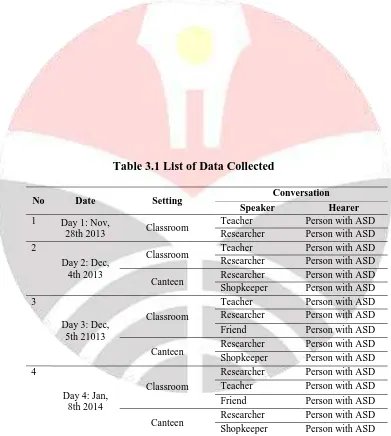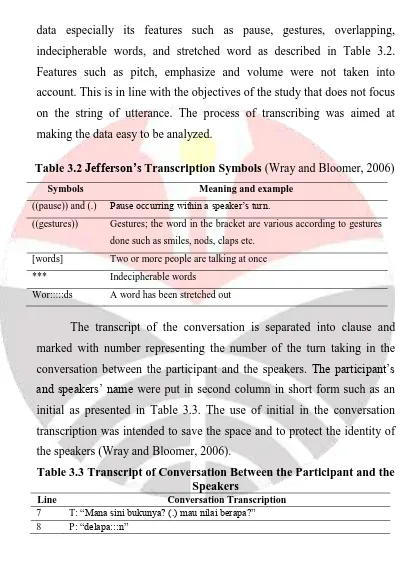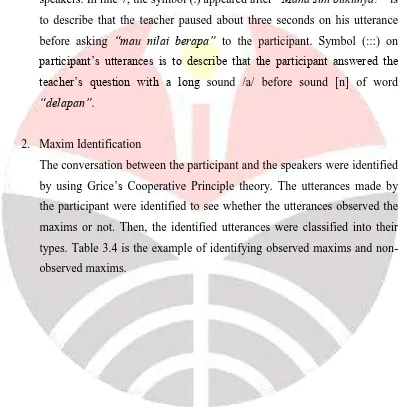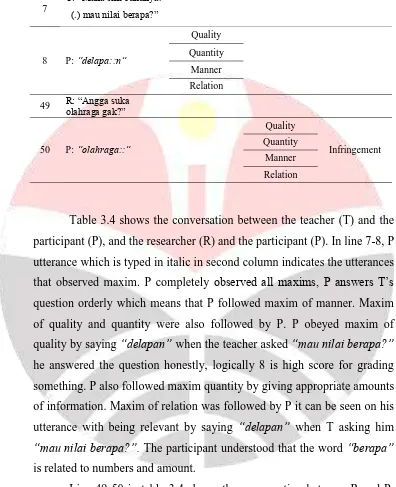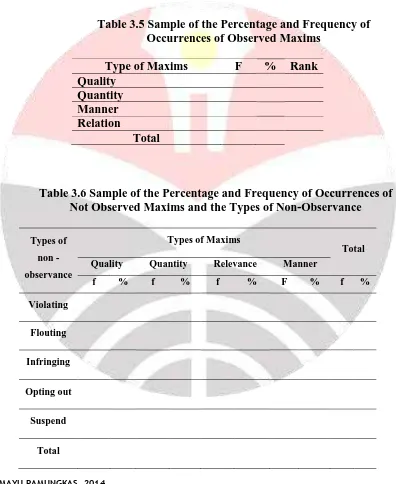MAYU PAMUNGKAS, 2014
A Grice’s Cooperative Principle Analysis Of A Person With Autistic Spectrum Disorder (ASD) Universitas Pendidikan Indonesia | repository.upi.edu | perpustakaan.upi.edu
ABSTRACT
A Grice’s Cooperative Principle Analysis of a Person with Autistic Spectrum Disorder (ASD)
(A Case Study of a 20 year-old Male with ASD in SLBC Sumbersari Bandung)
Mayu Pamungkas (0907195)
Main Supervisor: Dadang Sudana, MA., Ph.D.
Co-Supervisor: R. Dian Dia-an Muniroh, S.Pd., M.Hum
The present study examines the types of maxims observed by a person with Autistic Spectrum Disorder (ASD), the types of maxims not observed and their non-observance, and factors contributing to the participant in observing and not observing the maxim. The data are in the form recorded observation of conversations with a person with ASD at SLBC Sumber Sari Bandung. The study employs a qualitative design with some measures of descriptive statistics. Grice’s Cooperative Principle theory (1975) is applied to analyze the realization of Grice’s Cooperative Principle in utterances produced by a person with ASD. The study shows that the participant mostly observes the four maxims indicated by providing truthful, sufficient, relevant and brief answers. Meanwhile, there are only two types of non-observance committed by the participant in this study, namely infringement and flouting. From the analysis, it is found that there are two factors that can cause a person with ASD to observe and not observe the maxims, namely his linguistic factors and his non linguistic factors.
Keywords: Autistic Spectrum Disorder (ASD), Grice’s Cooperative Principle, Non
MAYU PAMUNGKAS, 2014
A Grice’s Cooperative Principle Analysis Of A Person With Autistic Spectrum Disorder (ASD) Universitas Pendidikan Indonesia | repository.upi.edu | perpustakaan.upi.edu
ABSTRAK
Sebuah Analisis Prinsip Kerjasama Grice pada Seseorang dengan Autistic Spectrum Disorder (ASD)
(Sebuah Studi Kasus pada Seorang Pria 20 tahun dengan ASD di SLBC Sumbersari Bandung)
Mayu Pamungkas (0907195)
Pembimbing 1: Dadang Sudana, MA., Ph.D.
Pembimbing 2: R. Dian Dia-an Muniroh, S.Pd., M.Hum
Penelitian ini meneliti jenis-jenis maksim yang ditaati oleh seorang dengan Autistic Spectrum Disorder (ASD), jenis-jenis maksim yang tidak ditaati beserta jenis non-observance, dan faktor-faktor yang mempengaruhi partisipan dalam mentaati dan melanggar maksim. Data yang digunakan dalam bentuk rekaman observasi dari percakapan seorang dengan ASD di SBLC Sumbersari Bandung. Penelitian ini menggunakan desain kualitatif dengan beberapa perhitungan statistik deskristif. Teori Prinsip Kerjasama Grice (1975) diaplikasikan untuk menganalisis realisasi Prinsip Kerjasama Grice dalam tuturan-tuturan yang diproduksi oleh seseorang dengan ASD. Penelitian ini menunjukkan bahwa partisipan lebih banyak mentaati keempat maksim, hal tersebut ditunjukan dengan partisipan mampu memproduksi tuturan yang jujur, tidak berlebihan, relevan dan jawaban yang jelas. Sementara itu, hanya ada dua jenis non-observance yang dilakukan oleh partisipan dalam penelitian ini, yaitu infringement dan flouting. Dari hasil analisis, ditemukan bahwa ada dua faktor yang dapat mempengaruhi partisipan dalam mentaati dan melanggar maksim, yaitu faktor linguistik dan faktor non-linguistik.
Kata Kunci : Autistic Spectrum Disorder (ASD), Prinsip Kerjasama Grice, Mentaati
MAYU PAMUNGKAS, 2014
A Grice’s Cooperative Principle Analysis Of A Person With Autistic Spectrum Disorder (ASD) Universitas Pendidikan Indonesia | repository.upi.edu | perpustakaan.upi.edu
25 CHAPTER III
RESEARCH METHOD
This chapter is intended to send forth descriptions of research of research design. It elaborates the source of data and provides steps of data collection and analysis.
3.1 Research Design
The study employed qualitative method embracing the characteristics of a case study with some measures of descriptive statistics. The qualitative method was employed due to a need for an intimate interaction with the participant. Qualitative method enabled the researcher to figure out a phenomenon in detail to define subject‟s behavior and interact intimately with the subject (Alwasilah, 2008, p. 108-109). The qualitative method involved the process of describing, analyzing, categorizing and interpreting the data.
Since the aims of the study were to describe, analyze, categorize and interpret the utterances made by the participant to identify how the realization of Grice‟s Cooperative Principle in utterances taken from a person with ASD, a qualitative method was considered appropriate for this study. Fraenkel et. al (2012) state that qualitative study is likely to observe the meaning that people give to certain words or action, how people interact with other, and how certain kinds of question are answered.
in-MAYU PAMUNGKAS, 2014
A Grice’s Cooperative Principle Analysis Of A Person With Autistic Spectrum Disorder (ASD) Universitas Pendidikan Indonesia | repository.upi.edu | perpustakaan.upi.edu
26
depth information on realization of Grice‟s Cooperative Principle in utterances produced by a person with ASD.
3.2 Data Collection
After elaborating the design of the study, this section is intended to elaborate the data sources as well as the procedures of data collection.
3.2.1 Source of Data
The data of this study were the utterances produced by a person with ASD when he communicated with the speakers ( teacher, researcher, friends and shopkeeper). More precisely, the participant involved in this study was a 20 year-old male with ASD who was the student of SLBC Sumbersari Bandung. The participant was chosen because the participant represented the characteristics of people with ASD. The participant had impairment in communication and was categorized autistic.
The conversation between the participant and the speakers took place at SLBC (special school BC) Sumbersari Bandung. SLBC Sumbersari Bandung was chosen as the setting of this study because the researcher had an access to conduct observation in that school. The researcher has been given permission by the principal to conduct observation to one of the students at SLBC Sumbersari Bandung.
3.2.2 Procedures of Data Collection
MAYU PAMUNGKAS, 2014
A Grice’s Cooperative Principle Analysis Of A Person With Autistic Spectrum Disorder (ASD) Universitas Pendidikan Indonesia | repository.upi.edu | perpustakaan.upi.edu
27
were made more accurate. Frechtling and Westat (2010) state that field note was useful to provide more in depth background or to help the researcher remember salient events.
The observation was conducted to observe how the participant communicates with the speakers at school. Specifically, the observation involved in this study was categorized as participant observation, because the researcher collected data by participating in participant‟s daily life (Mac and Ghaill, 1994 cited in Smith, 1997). The observation was intended to collect natural data. However, because of the limitation of memory, the researcher used voice recorder to record the conversation. Audio recording was used to record conversation between the participant and the speakers. Recorded observation was vital in this study to help the researcher re-track the data.
In recording the conversation, the researcher faced some difficulties. In some circumstances the researcher was not able to record the conversation because of the participant‟s behavior such as flapping, hyper active, and echolalia. In order to overcome that problem, the researcher did a field note to complete the data when they could not be obtained by the recorder.
MAYU PAMUNGKAS, 2014
A Grice’s Cooperative Principle Analysis Of A Person With Autistic Spectrum Disorder (ASD) Universitas Pendidikan Indonesia | repository.upi.edu | perpustakaan.upi.edu
28
Table 3.1 List of Data Collected
No Date Setting Conversation
Speaker Hearer
1 Day 1: Nov,
28th 2013 Classroom
Teacher Person with ASD
Researcher Person with ASD
2
Day 2: Dec, 4th 2013
Classroom Teacher Person with ASD
Researcher Person with ASD
Canteen Researcher Person with ASD
Shopkeeper Person with ASD
3
Day 3: Dec, 5th 21013
Classroom
Teacher Person with ASD
Researcher Person with ASD
Friend Person with ASD
Canteen Researcher Person with ASD
Shopkeeper Person with ASD
4
Day 4: Jan, 8th 2014
Classroom
Researcher Person with ASD
Teacher Person with ASD
Friend Person with ASD
Canteen Researcher Person with ASD
MAYU PAMUNGKAS, 2014
A Grice’s Cooperative Principle Analysis Of A Person With Autistic Spectrum Disorder (ASD) Universitas Pendidikan Indonesia | repository.upi.edu | perpustakaan.upi.edu
29
From Table 3.1, it can be seen that the settings of the conversation between the participant and the speakers took place in two places; classroom and canteen. As can be seen in the Table 3.1, the observation was conducted four times, in the classroom the conversation was conducted four times while in the canteen the conversation was conducted three times. The observation was mostly done in the classroom because in that setting the participant had a tendency to be quiet and could be controlled. In contrast, in the canteen the participant tends to be hyper active and uncontrolled, so the researcher had a hard time to have an interaction with the participant during lunch time.
3.3 Data Analysis
The data of this study were obtained by observation, audio recording and field note. The data were in the form of conversations, however not all of the recorded conversations were analyzed; only those containing questions and answers were used. From 828 lines of conversation, there were 410 lines containing question and answer, and there were 205 utterances produced by the participant that were analyzed using Grice‟s Cooperative Principle theory.
The analysis involved several steps: transcribing the recorded conversation, identifying the conversation between the participant and the speakers by using Grice‟s Cooperative Principle theory, classifying the types of maxim observed and types of non-observance, and calculating the percentages and frequency of occurrences of observed and non-observed maxims and the types of non-observance. The steps are elaborated as follows.
1. Conversation Transcription
MAYU PAMUNGKAS, 2014
A Grice’s Cooperative Principle Analysis Of A Person With Autistic Spectrum Disorder (ASD) Universitas Pendidikan Indonesia | repository.upi.edu | perpustakaan.upi.edu
30
data especially its features such as pause, gestures, overlapping, indecipherable words, and stretched word as described in Table 3.2. Features such as pitch, emphasize and volume were not taken into account. This is in line with the objectives of the study that does not focus on the string of utterance. The process of transcribing was aimed at making the data easy to be analyzed.
Table 3.2 Jefferson’s Transcription Symbols (Wray and Bloomer, 2006)
Symbols Meaning and example
((pause)) and (.) Pause occurring within a speaker‟s turn.
((gestures)) Gestures; the word in the bracket are various according to gestures
done such as smiles, nods, claps etc.
[words] Two or more people are talking at once
*** Indecipherable words
Wor:::::ds A word has been stretched out
The transcript of the conversation is separated into clause and marked with number representing the number of the turn taking in the conversation between the participant and the speakers. The participant‟s and speakers‟ name were put in second column in short form such as an initial as presented in Table 3.3. The use of initial in the conversation transcription was intended to save the space and to protect the identity of the speakers (Wray and Bloomer, 2006).
Table 3.3 Transcript of Conversation Between the Participant and the Speakers
Line Conversation Transcription
7 T: “Mana sini bukunya? (.) mau nilai berapa?”
MAYU PAMUNGKAS, 2014
A Grice’s Cooperative Principle Analysis Of A Person With Autistic Spectrum Disorder (ASD) Universitas Pendidikan Indonesia | repository.upi.edu | perpustakaan.upi.edu
31
Table 3.3 provides the example of the transcript of conversation between the teacher (T) and the participant (P). The numbers displayed in the „line‟ column refer to the turn taking between the participant and the speakers. In line 7, the symbol (.) appeared after “Mana sini bukunya?” is to describe that the teacher paused about three seconds on his utterance before asking “mau nilai berapa” to the participant. Symbol (:::) on participant‟s utterances is to describe that the participant answered the teacher‟s question with a long sound /a/ before sound [n] of word “delapan”.
2. Maxim Identification
The conversation between the participant and the speakers were identified by using Grice‟s Cooperative Principle theory. The utterances made by the participant were identified to see whether the utterances observed the maxims or not. Then, the identified utterances were classified into their types. Table 3.4 is the example of identifying observed maxims and non-observed maxims.
Table 3.4 Example of Maxim Identification
Line Conversation
Transcription
Observed Maxims
Non-observed Maxims
MAYU PAMUNGKAS, 2014
A Grice’s Cooperative Principle Analysis Of A Person With Autistic Spectrum Disorder (ASD) Universitas Pendidikan Indonesia | repository.upi.edu | perpustakaan.upi.edu
32 7
T: “Mana sini bukunya? (.) mau nilai berapa?”
8 P: “delapa::n”
Quality Quantity
Manner Relation
49 R: “Angga suka olahraga gak?”
50 P: “olahraga::”
Quality
Infringement Quantity
Manner Relation
Table 3.4 shows the conversation between the teacher (T) and the participant (P), and the researcher (R) and the participant (P). In line 7-8, P utterance which is typed in italic in second column indicates the utterances that observed maxim. P completely observed all maxims, P answers T‟s question orderly which means that P followed maxim of manner. Maxim of quality and quantity were also followed by P. P obeyed maxim of quality by saying “delapan” when the teacher asked “mau nilai berapa?” he answered the question honestly, logically 8 is high score for grading something. P also followed maxim quantity by giving appropriate amounts of information. Maxim of relation was followed by P it can be seen on his utterance with being relevant by saying “delapan” when T asking him “mau nilai berapa?”. The participant understood that the word “berapa” is related to numbers and amount.
MAYU PAMUNGKAS, 2014
A Grice’s Cooperative Principle Analysis Of A Person With Autistic Spectrum Disorder (ASD) Universitas Pendidikan Indonesia | repository.upi.edu | perpustakaan.upi.edu
33
indicates that the utterance totally breaks all maxims. P breaks maxim of relation by answering the question with irrelevant information with the topic being discussed. P breaks maxim of quantity by giving inappropriate answer when being asked with „Yes or No‟ question. Maxim of quality and manner also were broken in P utterance. P answered the question with ambiguous word. Infringement is categorized as the types of non-observance on P utterances in line 50. P had no intention to mislead or generate an implicature. It was because P has impaired linguistics performance (echolalia).
3. Data calculation
The occurrences were calculated after all the data were classified into their types. Table 3.5 and 3.6 presented the percentages and frequency of occurrences of observed and observed maxims, and the types of observance. To count the frequency of each observed maxim, non-observed maxim, and the types of non-observance, the formula used is as follows.
P = x 100%
P = Percentage
MAYU PAMUNGKAS, 2014
A Grice’s Cooperative Principle Analysis Of A Person With Autistic Spectrum Disorder (ASD) Universitas Pendidikan Indonesia | repository.upi.edu | perpustakaan.upi.edu
34
Table 3.5 Sample of the Percentage and Frequency of Occurrences of Observed Maxims
Type of Maxims F % Rank
Quality Quantity Manner Relation
Total
Table 3.6 Sample of the Percentage and Frequency of Occurrences of Not Observed Maxims and the Types of Non-Observance
Types of
non
-observance
Types of Maxims
Total
Quality Quantity Relevance Manner
f % f % f % F % f %
Violating
Flouting
Infringing
Opting out
Suspend
MAYU PAMUNGKAS, 2014
A Grice’s Cooperative Principle Analysis Of A Person With Autistic Spectrum Disorder (ASD) Universitas Pendidikan Indonesia | repository.upi.edu | perpustakaan.upi.edu
35
Rank
